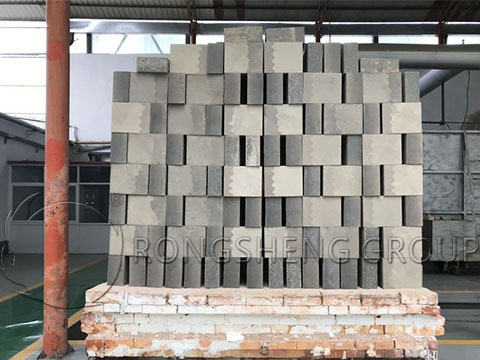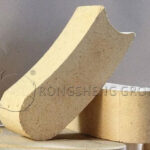Phosphate-bonded high alumina bricks are often used as lining materials in cement-coordinated waste incineration rotary kilns. Due to their good wear resistance, they can be used 2 to 3 times longer in the transition zone and cooling zone of the kiln than ordinary high alumina bricks. Rongsheng High Alumina Refractory Bricks Manufacturer provides high-quality high alumina bricks, phosphate-bonded high alumina bricks, and refractory lining materials for waste incinerators. Contact Rongsheng for free samples and quotes.

Mechanism of Phosphate bonded High Alumina Bricks for Kiln Lining
When used as the lining of a waste incinerator, the specific mechanism of phosphate-bonded high-alumina bricks for kiln lining is as follows:
1) Phosphate-bonded high-alumina bricks and phosphate wear-resistant bricks are used as lining materials for waste incineration power generation cement rotary kiln. Under the appropriate combustion temperature of garbage and coal powder and the participation of molten coal ash, a 15%~20% liquid phase will be formed on the surface of the refractory bricks. At the same time, the amount of liquid phase produced by cement clinker is about 20%~25%. When the liquid phase and viscosity between the clinker and the surface of the kiln lining refractory bricks reach a certain level, the first layer of kiln lining begins to stick. A reaction occurs between the kiln lining and the brick surface, that is, between the waste incineration ash powder and the clinker, coal ash and refractory bricks. The reaction also penetrates to a certain depth of the brick surface, and its penetration depth mainly depends on the chemical composition of the refractory bricks and the waste incineration ash powder, clinker and coal ash. When the phosphate-bonded high-alumina brick Al2O3≥80%, the first layer of kiln lining and the penetration layer generated are mainly C2AS.
2) The firmness and density of the kiln lining of phosphate-bonded high-alumina bricks mainly depends on the generated C2AS. The more C2AS and the less CAS2, the firmer and firmer the kiln lining is, and vice versa. The changes in the silicon rate and aluminum rate of the clinker also play a decisive role in whether the kiln lining can be firmly hung. The higher the content of Fe2O3 and K2O+N2O in the clinker, the more molten minerals are generated, and the looser the kiln lining is. Therefore, the performance of the kiln lining of phosphate-bonded high-alumina bricks as lining materials for waste incineration power generation cement rotary kilns depends on the content and chemical composition of AI2O3 and Fe2O3 in waste incineration ash, coal ash and cement materials. The supply of CaO in the material to the brick surface metamorphic layer and the depth of reaction penetration are also important reasons that directly affect the firmness and density of the kiln lining.
3) Phosphate-bonded high-alumina bricks as lining materials for waste incineration power generation cement rotary kilns. Practice has proved that phosphate-bonded high-alumina bricks containing Al2O3 ≥ 80% are used as kiln lining materials. When the temperature is lower than 1450℃, the amount of liquid phase is insufficient, and the kiln skin cannot be hung or cannot be hung firmly. When the temperature is higher than 1490℃, the amount of liquid phase is too much and it is very easy to produce burning flow. Therefore, the normal kiln skin control temperature difference of the waste incineration power generation cement rotary kiln is 20℃~30℃.

4) When the temperature is low, the kiln skin cannot be hung or cannot be hung firmly, so that there is a lack of a kiln skin of sufficient thickness for protection between the brick surface and the ash powder and materials in the kiln. For machine-pressed phosphate combined with high-alumina bricks, due to their high density and high thermal conductivity, if the kiln lining bricks are not thick and the kiln skin is hung too thin, it is very easy to cause the cylinder to redden.
5) When the staff operates carelessly, there is insufficient material or coal leakage or too little garbage, and the exhaust cannot be increased in time. The flame extends deep into the kiln to the position where the kiln skin is not thick enough, and the accumulation of materials in the kiln will also cause local temperature rise in the kiln, causing the kiln skin and kiln lining to melt rapidly. Therefore, when using phosphate combined with high-alumina bricks as decomposition zone and preheating zone kiln lining materials, the accumulation and agglomeration of local materials in the kiln should be prevented.
6) Phosphate combined alumina bricks as waste incineration power generation rotary kiln lining materials often cause the brick lining to heat up too quickly when the kiln is opened, and cool too quickly when the kiln is stopped, causing damage to the kiln skin. When the kiln skin falls off, the temperature of the brick surface rises rapidly by 500℃~600℃, causing the brick body to be damaged by strong thermal shock. When the kiln is stopped, cold air quickly enters the kiln, causing the temperature of the brick body to drop sharply, causing the original cracks on the brick surface to expand rapidly and cause explosions. Therefore, the thermal shock caused by drastic temperature changes must be strictly controlled.
The amount of garbage and coal powder should be uniform to avoid high and low temperatures, which will cause unstable air flow temperature in the kiln. When the temperature is controlled at 1450℃~1490℃ and C2AS is generated on the surface of the refractory bricks, the kiln skin can be hung well, and it will not crack or peel off during frequent kiln stops.

Characteristics of Phosphate bonded High Alumina Bricks as High-Temperature Furnace Lining Materials
The physical and chemical indicators of phosphate-bonded high-alumina bricks are refractoriness ≥1970℃, and load softening point temperature greater than 1350℃. Volume capacity ≥2.75g/cm3, room temperature compressive strength ≥61.8MPa. It has high-temperature compressive strength, good thermal shock stability, and low wear resistance. The main characteristics of phosphate-bonded high-alumina bricks from Rongsheng manufacturers. Contact Rongsheng for detailed information for free.








